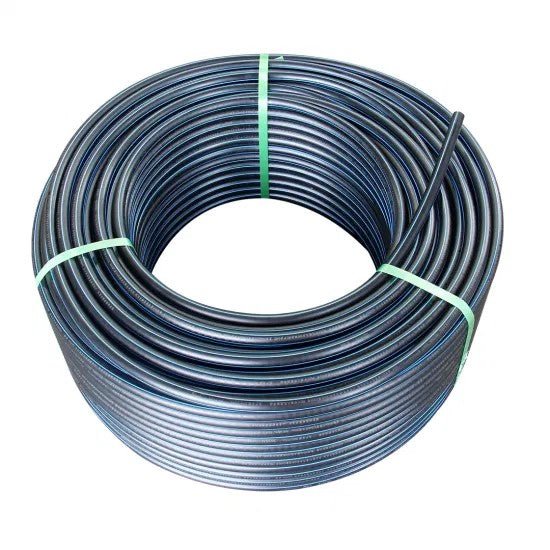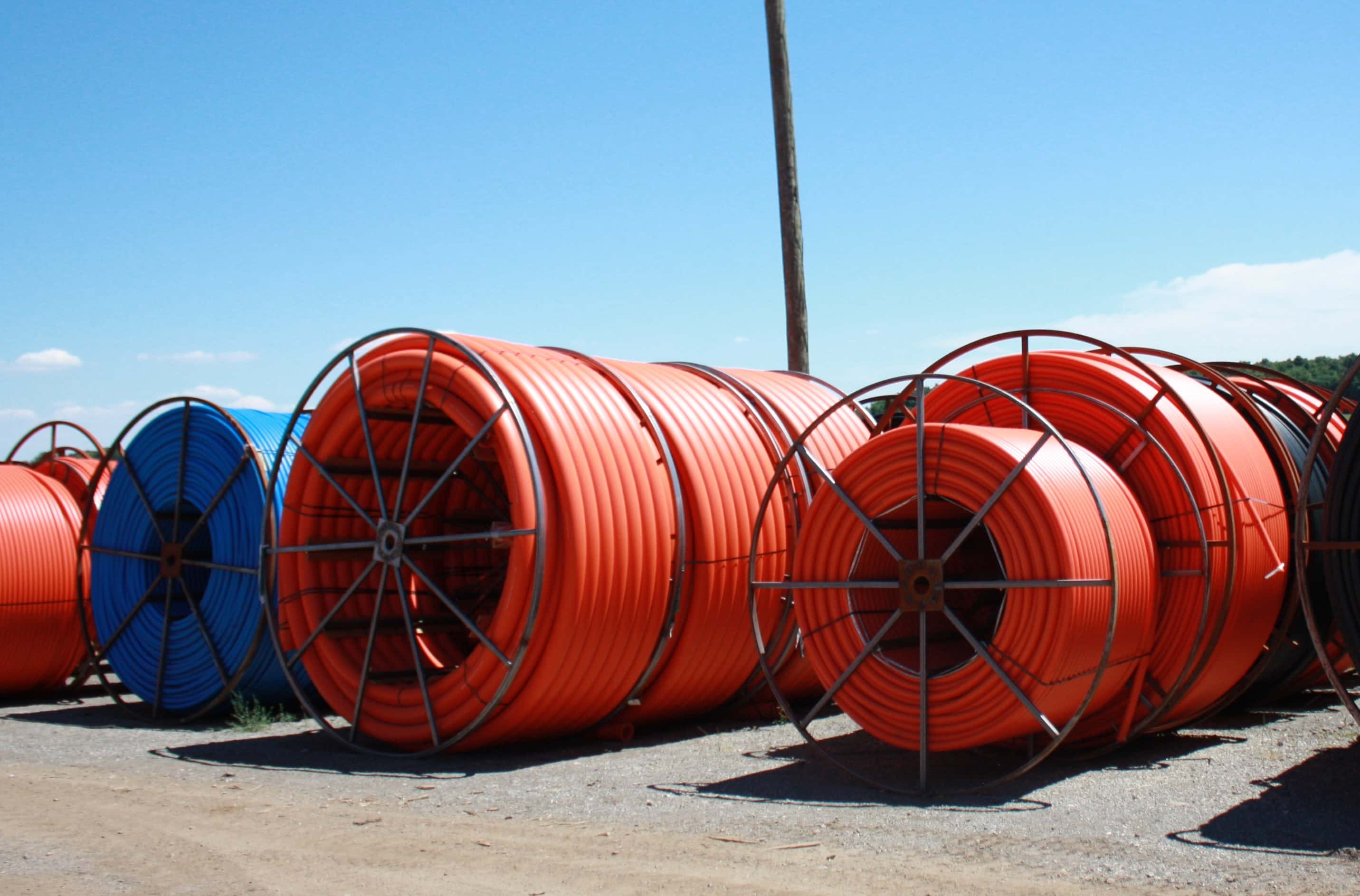Explore the Manufacturing Refine Behind High-Quality HDPE Pipe and Its Applications
The manufacturing procedure of top notch HDPE pipelines is complex and systematic. It begins with the option of basic materials that boost performance. Following this, ethylene undertakes polymerization to develop resin, which is then formed through extrusion. Quality assurance is critical, guaranteeing that the end product satisfies rigid standards. The journey of HDPE pipes doesn't finish with manufacturing. Their applications throughout different industries disclose a broader relevance worth analyzing.
Recognizing HDPE: Features and Advantages

High-density polyethylene (HDPE) is a flexible polycarbonate recognized for its resilience and resistance to different environmental aspects. This product shows outstanding tensile stamina, making it suitable for demanding applications. Its low-density structure contributes to a lightweight item, helping with simplicity of managing and setup. HDPE likewise showcases exceptional resistance to chemicals, which lessens destruction when revealed to severe compounds.
The product's low moisture absorption better enhances its longevity, making it excellent for use in pipes and tank. Additionally, HDPE is resistant to ultraviolet (UV) radiation, ensuring that products maintain their honesty also when revealed to sunshine. Its adaptability allows for the creation of detailed shapes without compromising strength. The environmentally friendly nature of HDPE, frequently originated from recycled products, includes in its appeal, advertising sustainable practices in manufacturing. Overall, these residential properties and benefits make HDPE a favored choice for numerous commercial and customer applications.
Raw Product Choice for HDPE Manufacturing
The selection of resources for HDPE manufacturing is crucial to confirm the final item meets the wanted specs and quality criteria. High-density polyethylene (HDPE) is mostly produced from polymerized ethylene, stemmed from fossil gas such as natural gas or petroleum. The high quality of these feedstocks considerably influences the mechanical and thermal residential properties of the final HDPE.
Ingredients also play a substantial role in boosting HDPE's performance, including antioxidants, UV stabilizers, and colorants, which boost durability and resistance to ecological elements. The selection procedure need to think about not only the chemical composition of the raw products yet additionally their handling attributes to ensure effective manufacturing.
The sourcing of raw products should prioritize sustainability and compliance with ecological laws, as liable practices are necessary in today's market. Ultimately, cautious basic material selection lays the structure for producing high-quality HDPE pipes appropriate for varied applications.
The Extrusion Refine: Forming HDPE Pipeline
The extrusion procedure plays an important function fit HDPE pipelines, starting with meticulous material preparation techniques that ensure excellent flow and consistency. Similarly essential is the style of the die, which directly influences the final dimensions and surface quality of the pipe. Together, these variables contribute substantially to the efficiency and high quality of HDPE pipeline manufacturing.
Material Preparation Methods
Reliable manufacturing of HDPE pipes begins with careful material preparation strategies, specifically the extrusion process. Throughout this phase, high-density polyethylene material is very first dried out to eliminate wetness, making sure ideal flow qualities. The material is after that fed into the extruder, where it undergoes home heating and melting, transforming into a thick state. This heating procedure is meticulously managed to maintain the product's stability and efficiency. The molten HDPE is forced via a die, shaping it right into a constant pipe form. Appropriate temperature level monitoring throughout extrusion is vital, as it directly influences the product's homes and the final product quality. As soon as shaped, the HDPE pipeline is cooled down and cut to specified lengths, all set for succeeding processing and applications.
Die Design Relevance
Precision in die layout plays a necessary role in the extrusion procedure of HDPE pipelines. The die functions as the last shaping tool, directly influencing the pipeline's dimensions, wall density, and surface area coating. A properly designed die guarantees consistent material flow, decreasing problems such as irregularities and vulnerable points. The geometry of the die must be maximized to fit the details residential or commercial properties of HDPE, including its thickness and thermal habits during extrusion. Furthermore, the cooling price of the material as it goes through the die can markedly affect the pipe's structural stability. Subsequently, buying innovative die technology is important for manufacturers aiming to generate premium HDPE pipes that satisfy market standards and customer expectations.
Quality Assurance Steps in HDPE Production
Various factors affect the top quality of HDPE pipeline production, efficient quality control measures are important to guarantee consistency and integrity in the last item (American Plastics HDPE Pipe Manufacturing). Secret high quality control techniques include extensive product inspection, validating that the raw polyethylene meets well established requirements for pureness and density. During the extrusion process, specifications such as temperature, stress, and cooling time are closely monitored to preserve dimensional precision and structural stability
Furthermore, post-production screening is essential; manufacturers commonly conduct hydrostatic examinations to evaluate the pipeline's strength and resistance to stress. Visual assessments for surface flaws further improve quality control. Certification from pertinent standards companies, like ASTM or ISO, provides an extra layer of reputation. By carrying out these extensive quality control measures, makers can reduce defects, boost performance, and ensure that the HDPE pipelines fulfill the details demands of numerous applications, inevitably bring about customer contentment and rely on the product.
Applications of HDPE Pipeline Throughout Industries
HDPE pipelines are utilized across various markets as a result of their resilience and pop over to this web-site adaptability. In water circulation systems, they assure efficient delivery, while in wastewater management, they give reliable services for waste transportation. Furthermore, farming Go Here watering networks take advantage of HDPE's resistance to deterioration and flexibility, making it a suitable choice for modern farming methods.

Water Circulation Solutions
A considerable number of industries depend on high-density polyethylene (HDPE) pipelines for effective water distribution systems. Known for their longevity and resistance to deterioration, HDPE pipes are widely made use of in metropolitan water supply networks, farming irrigation, and commercial applications. Their lightweight nature assists in very easy handling and setup, lowering labor costs and time. Furthermore, HDPE pipelines can accommodate different stress degrees, making them suitable for both low and high-pressure systems. hdpe pipe fittings Midland TX. The adaptability of the product enables seamless combination right into existing framework, reducing the demand for extensive excavation. Moreover, HDPE's resistance to chemical seeping warranties that the water provided stays safe and tidy, making it a suitable option for maintaining the quality of drinkable water across different fields
Wastewater Administration Solutions
Efficient water distribution systems additionally lead the way for innovative wastewater monitoring options, where high-density polyethylene (HDPE) pipes play a considerable role. Renowned for their resilience and resistance to deterioration, HDPE pipelines are suitable for delivering wastewater in different setups. Their versatility permits easy installment in intricate atmospheres, reducing the need for comprehensive excavation. In addition, HDPE's smooth indoor surface minimizes friction, boosting circulation rates and efficiency. These pipelines are also resistant to chemical leaching, making certain that contaminants do not jeopardize the surrounding setting. Industries, towns, and therapy centers increasingly count on HDPE pipes for their reliability and long life, making them a recommended option for modern-day wastewater management systems. This versatility underscores the essential relevance of HDPE pipelines across various applications.
Agricultural Irrigation Networks
Agricultural irrigation networks profit greatly from using high-density polyethylene (HDPE) pipes, which supply reliable and reputable water distribution to plants. HDPE pipelines are lightweight, making them very easy to transfer and set up, while their versatility enables for different setups in varied surfaces. These pipes demonstrate exceptional resistance to deterioration, chemicals, and UV radiation, making certain durability in harsh agricultural environments. Additionally, their smooth interior surface area decreases rubbing loss, maximizing water circulation and lowering power prices related to pumping. The long life of HDPE pipelines, often exceeding 50 years, adds to reduce upkeep and substitute expenditures. Farmers significantly depend on HDPE pipes to improve watering effectiveness and promote lasting farming practices, ultimately leading to enhanced plant returns and resource conservation.

Future Trends in HDPE Pipe Innovation
As the need for lasting and reliable framework expands, advancements in HDPE pipe technology are poised to transform various industries. Emerging trends include the combination of smart technologies, such as sensors and IoT abilities, which assist in real-time surveillance of pipeline problems, lowering upkeep costs and avoiding leaks. Furthermore, the growth of innovative production techniques, such as 3D printing, is enabling the production of complex, customized pipeline layouts that click for source accommodate certain task demands.
The emphasis on recycling and circular economic climate methods is driving the advancement of HDPE pipelines made from recycled products, improving sustainability. Enhanced jointing methods, such as electro-fusion and mechanical fittings, are additionally enhancing installment effectiveness and integrity. The expanding focus on environmental guidelines is pressing manufacturers to embrace greener manufacturing processes, making certain that HDPE pipes not just satisfy sector requirements yet likewise cultivate a more lasting future for infrastructure advancement.
Frequently Asked Concerns
Just How Does HDPE Compare to Various Other Plastic Materials?
HDPE surpasses numerous various other plastic materials relating to resilience, chemical resistance, and adaptability. Its reduced density and high tensile stamina make it ideal for different applications, often exceeding choices in both efficiency and longevity.
What Are the Environmental Influences of HDPE Production?
The environmental effects of HDPE manufacturing include greenhouse gas emissions, power intake, and potential contamination from manufacturing processes. In addition, incorrect disposal can bring about dirt and water contamination, raising problems concerning long-lasting environmental effects.
Can HDPE Water Lines Be Recycled?
Yes, HDPE pipelines can be reused. Many facilities approve utilized HDPE for handling, changing it into new products. This reusing adds to sustainability efforts, decreasing plastic waste while preserving sources and energy in the manufacturing cycle.
What Is the Life-span of HDPE Piping?

Just How Do Temperature Variants Influence HDPE Pipe Performance?
Temperature level variants considerably impact HDPE pipe efficiency, impacting flexibility and stamina. High temperature levels can result in softening, while reduced temperatures might trigger brittleness, eventually influencing the pipe's resilience and viability for numerous applications in varied environments.